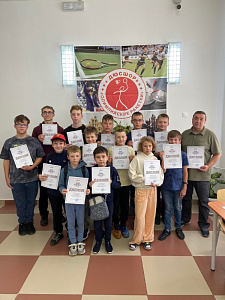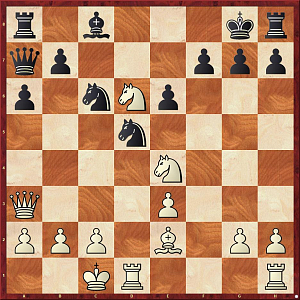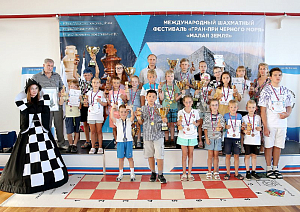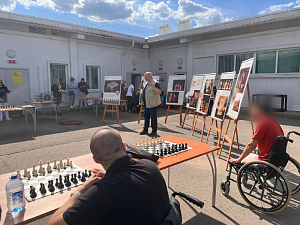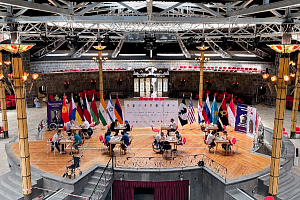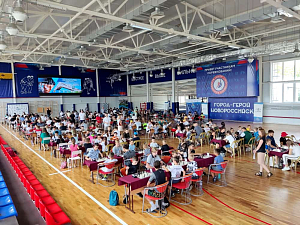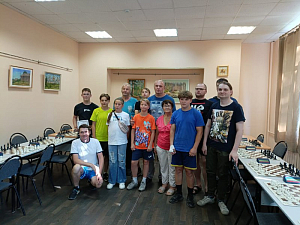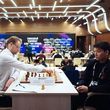29 November 2020
Fireworks Safety
Vladimir Barsky reviews Rounds 4-6 of the Russian Team Championships
The match outcome was sealed on the top two boards. The world Vice-champion of the long-ago year 2004 struck first to bring her team forward. A true master never fades away!
Kovalevskaya (FShM) – Girya (Ugra)
Round Four
.jpg)
Black on move
21...f5?!
Black must have regretted this king's weakening move down the road.
22.a6 exd4 23.Nd6!
A very strong intermezzo. Black's calculation probably stemmed from 23. exd4 bxa6 24. Rxa6 Nxd4! 25. Nxd4 Qxc5 26. Ra4 Ra8, etc.
23...dxe3 24.Qxd5+ Kh8 25.axb7 Nb8 26.Rd3
That's it, strictly speaking, because there is no holding the white passers without sacrificing much material.
26…Rd7 27.c6 Rc7 28.Nc8
28.Qc4 Qf6 29.Nb5 is tougher. Now Olga starts spicing things up even at the cost of significant material investments.
28...Rcxc8 29.bxc8Q Rxc8 30.Qd6 Qa7 31.Re1 Nxc6 32.Bxc6 e2+ 33.Kh2 Qf2
.jpg)
34.Qg3
Having only a minute and a half on her clock (the time pressure was mutual, by the way), Ekaterina missed the convincing: 34.Qe7! Qf4+ 35.g3 Qc4 (35...Qf2+ 36.Bg2) 36.Rd8+.
34...Qxg3+ 35.Kxg3 Be5+ 36.Kf3
White should have avoided the trade of rooks now and the next move.
36…Rxc6 37.Rxe2 Rc5?
Missing the last opportunity: the position arising after 37...Rc3! 38.Rxc3 Bxc3 is a fortress.
38.Rd7 Kg8 39.Ra2 Rc3+ 40.Ke2 Rc8 41.Raa7
The time control is over, and both rooks are in the refreshment stall now. The rest is easy.
41…Bf6 42.Rxh7 Rc2+ 43.Kd1 Ra2
Black turns to the exchange of a pair of rooks to stop the linear checkmate.
44.Rhb7 Rxa7 45.Rxa7 Bg7 46.Ke2 Kh7 47.Kd3 Kh6 48.Kc4 Be5 49.Kd5 Bg3 50.Ke6 f4 51.Kf7 g5 52.Ra6+ Kh7 53.Kf6 Kh6 54.Kf5+ Kh5 55.Ra8 Kh6 56.Rh8+ Kg7 57.Rh5 Black resigned.
The 2015 vice-world champion could have equalized the score after first outwitting her younger opponent, but then stumbling when victory was almost in her pocket.
Pogonina (Ugra) – Shuvalova (FShM)
Round Four
.jpg)
Black on move
47...Kg7?
Overlooking White's idea. 47...Be8 48.Qc8 Qb5 was maintaining the balance.
48.f6+! Kxf6 49.Qh8+ Ke7 50.Qxh6 Qb4
Black's margin of safety is substantial, but calculating over the board such lines as 50...Qd1 51.Qxg5+ Kf8! 52.Qd8+ Kg7!! 53.Qxd7 c3 or 52.Qe3 Kg8 53.Qc3 Qd3 is far from easy. Polina should have figured out that tucking away the king was of paramount importance, and that a strong c-passer and the exposed position of the white king would secure her half a point.
51.Qxg5+ Ke8
Black should have tucked her king into the kingside instead: 51...Kf8 52.Qd8+ Be8 53.d6 Qe1 54.Qf6 Kg8.
52.Qe5+ Qe7 53.Qb8+ Qd8 54.Qf4 Bb5?
A decisive mistake, 54...Qe7 was a tougher move.
55.d6! f6 56.Bd5 Qa5 57.Qe3+ Kd8 58.Qe7+ Kc8 59.Qe6+ Kd8 60.Qxf6+ Kd7 61.Qe7+ Kc8
.jpg)
62.Qe6+
62.g5! was a quick decider. You only need to spot that 62...c3 plugs the a5-d2 diagonal and opens the d5-a2 diagonal, i.e. that the black queen has no more checks to deliver. It means that 63.Qb7+! Kd8 64.Be6 is an inevitable checkmate. 62…Qd2+ 63.Kg3 Qc3+ 64.Bf3 Qa5 65.g6 saves neither as Black runs out of checks, and the white pawn is about to queen.
62...Kd8 63.Qe7+ Kc8 64.Be6+ Kb8 65.Qf8+ Ka7 66.Qg7+ Kb8 67.Qh8+
The immediate queen centralization is more straightforward – 67. Qd4.
67...Ka7 68.Qd4+ Qb6 69.Qxb6+
White was obviously willing to press his material advantage home without much hassle and without blundering some random check along the way. White could have kept the queens on the board with 69.Qf4 c3 70.Bf5 Qc5 71.Bc2, and Black is in bad shape.
69...Kxb6 70.h4?
This hasty move lets go of the victory. 70.Bf5! was correct, but the subsequent lines are not that simple:
1) 70…c3 71.Bc2 Kc6 72.h4 Kxd6 73.h5 Ke5 74.h6 Kf6 75.Kg3 Be8 76.g5+ Kf7 77.Kf4 Kg8 78.Ke5 – and the two connected passers will close it off;
2) 70…Ba4 71.Kg3 c3 (71…Kc6 72.d7 Kc7 73.Kf3 c3 74.Ke3) 72.Kf4 c2 73.Bxc2 Bxc2 74.h4 Kc6 75.Ke5 – and three pawns are superior to the bishop.
70...c3 71.Bf5
.jpg)
71...Bd7?
It is nearly impossible to see the next spectacular move in time pressure and not to make it! It justified itself completely from the psychological point of view, but stronger was 71...Ba4! 72.h5 c2 73.Bxc2 Bxc2 74.g5 Kc6 75.Kg3 Kxd6 76.Kf4 Ke6 with a draw.
72.Bc2?
this is understandable: if you miss an unexpected move, you want to put the bishop to a safe square, block the passer… Meanwhile, it was necessary to retreat it one square only - 72. Be4!, cutting off the enemy king from the d6-passer. After 72…Bxg4 73.Kg3 Bd1 74.Kf4 c2 75.Bxc2 Bxc2 76.Ke5 there is no stopping the white king from showing up on е7, and the black bishop falls victim to the trick known in chess as "trousers".
72...Bxg4 73.Kg3 Bh5 74.Kf4 Kc6 75.Ke5 Kd7 76.Ba4+ Kd8 77.Kd4 Be8!
With the help of such small stabs, black does not allow the opponent's king to move away from the d6-pawn and get away with the c3-passer unpunished.
78.Bc2 Kd7 79.Kc5 Bh5 80.Bf5+ Kd8 81.Kd4 Bg4 82.Bc2 Kd7 83.Ke5 Bh5 84.Ba4+ Kd8 85.Kf6 Be8 86.Bb3 Kd7 87.Ke5 Bg6 88.Ba4+ Kd8 a draw that allowed FShM to clinch a 2.5:1.5 victory.
Following this round, the St. Petersburg team SShOR ShSh grabbed the lead after whitewashing the Moscow Oblast team with a 4:0 score.
Protopopova (Moscow Oblast) – Bodnaruk (SShOR ShSh)
Round Four
.jpg)
White on move
The pawn structure does little to tell you that it was actually the KID. White could have gained a substantial edge with: 30.Nf5! Rh2 31.Ne7+ Kh7 32.Nxg6 Rxf2 (32...Kxg6 33.Nf4+! Kg5 34.Qxh2) 33.Nxe5 dxe5 34.g5 Ne4 35.g6+ or 33…Nxe5 34.Ng5+ Kg6 35.Ne4. However, Protopopova was carried away with another idea that looked seemingly stronger.
30.g5
What is Black supposed to do? Taking the knight to d7 to cover the f8-square seems necessary, but then 31. Nf4 with material acquisitions. However, Anastasia has an insidious blow up her sleeve.
30...Rh2!! 31.Qxh2 Qe3+ 32.Kd1?
White loses the thread. She should have retreated the rook immediately with 32.Qd2 Qxg1+, and after something like 33.Qd1 Qxg3 34.gxf6 Kf7 35.Qe2 Kxf6 36.Kd2 the position is level.
32...Ng4! 33.Qe2
This is forced because 33.Qg2 runs into 33…Nf2+.
33...Qxg1+ 34.Nf1
.jpg)
34…Bd3! 35.Qf3
There is no touching the bishop: 35.Qxd3 Nf2+.
35...Qxf1+ 36.Qxf1 Bxf1 37.b3 b5 38.Ke1 Bd3 39.Kd2 bxc4 40.Kc3 Ne5 41.Nc7 Kf7 42.Nb5 cxb3 43.Nxd6+ Ke7 44.Nc8+ Kd7 45.Nxa7 bxa2 46.Kb2 Bc4 47.d6 Nd3+ 48.Ka1 Nb4 White resigned.
The next day, there took place yet another change of lead after FSM defeated SShOR ShSh with a minimum score.
Shuvalova (FShM) – Bodnaruk (SShOR ShSh)
Round Five
.jpg)
White on move
Tigran Petrosian used to say his summer cottage was “financed” by the KID Defense. Nastya Bodnaruk also seems to fare from this debut, otherwise she wouldn't have employed it regularly for so many years now. However, something went wrong for her in this game. Black's position is rather "loose": both flanks are weak and there is no real counterplay against the opponent's king. Shuvalova gradually pushes back the opponent's pieces.
23.Nh2 Nd4 24.Qa3 Bh5
You need to retreat because 24...Ne2+ 25.Kf1 Nxc1 26.Nxg4 is bad.
25.Nxd6 Ne2+ 26.Rxe2 Bxe2 27.Nb7!
The knight clears the way for his passed pawn.
27...Qd7 28.d6 Ng6 29.Qe3 Bg4 30.Bd5+ Kh8 31.Rc7 Qf5 32.f3
The immediate 32.Rxg7! was also possible.
32...Bh3 33.Rxg7! Qb1+
Or 33...Kxg7 34.Qxh6+ Kf6 35.g4 Qb1+ 36.Kf2.
34.Kf2
.jpg)
34...Rxf3+
Black's situation is hopeless, and the sacrificial fireworks only last him until time control.
35.Bxf3 Kxg7 36.Qxh6+ Kf6 37.Qxh3 Rh8 38.Ng4+ Ke6 39.Nh6+ Kf6 40.Qd7 Rxh6 41.Bxh6 Qxb2+ 42.Be2 Black resigns.
Fireworks happened in the men's championship as well. This is, perhaps, the most visual, but the mysterious of all such cases.
Antipov (Molodezhka) – Musalov (Kimmeria)
Round Six
1.e4 e5 2.Nf3 Nc6 3.Bb5 a6 4.Ba4 Nf6 5.d3 d6 6.c4 g6 7.Nc3 Bg7 8.Nd5 Nd7 9.Bg5 f6 10.Be3 Ne7
.jpg)
The prosaic continuation 11. d4 c6 12. Nc3 with a significant advantage did not suit Mikhail Antipov for some reason, and he decided to create his own "immortal" game.
11.Ng5!?
The mind-boggling blow 11.Nxe5 got into the broadcast by mistake - too beautiful to be true, but the author of these lines was the first victim who fell for it.
11...fxg5
This is forced because something like 11...Nxd5 12.Ne6 Nxe3 13.fxe3 Qe7 14.Nxc7+ is bad for Black.
12.Bg5 Bf8 13.f4
A draw by repetition was 13.Nf6+ Kf7 14.Bxd7 Bxd7 15.Qf3 Kg7 16.Nd5 Kg8 17.Nf6+, but it is clearly not for the sake of this quick draw that Mikhail, a brilliant tactician, has brewed this combination. However, he must have underestimated some defensive resource of his opponent’s.
13...c6 14.fxe5 cxd5 15.0–0 b5 16.d4 Qb6 17.exd5 bxa4 18.exd6
.jpg)
What a spectacular setup! However, aloof to any visual effects, the engine's evaluation is -5.
18...Bg7 19.c5 Qxb2 20.Kh1
If 20.dxe7, then 20…Qxd4+ with an exchange of queens.
20...Qxd4 21.Qe1 Qe5 22.Qd2 Qxd5 23.Qe3 Qe5 24.Qf3 Qd5 25.Qe3 Qe5 26.Qf3
.jpg)
Is it going to end in a threefold repetition after all? Not really.
26...Qxg5 27.Qf7+ Kd8 28.Rae1 Be5 29.dxe7+ Qxe7 30.Qd5 Ra7 31.c6 Qc5 32.Qe4 Nf6 33.Qxa4 Re7 34.Rb1 Ke8 35.Rfc1 Qd4 White resigned: he is down three pieces and there are no more bullets to keep up the fight.
And here is an example of a lot more well-prepared attack.
Esipenko (FShM) – Sakaev (Mednyi Vsadnik)
Round Four
Not only did Esipenko opt for the Karpov's favorite 6. Be2 in response to the Najdorf system, but he otherwise delivered the whole game in the Karpovian style.
.jpg)
White on move
Now the black knight intends to plant itself on f5. White nips the idea in the bud without any second thoughts.
19.g4! Ne4 20.Qg2 Nc5 21.b3 Nd7 22.Kh1 Nb6 23.Ne3 Qd8 24.Bb5 Rf8
.jpg)
25.Nf5!?
They taught in the old days that the knight belongs to this square! The engine votes for 25.f4, which looks stronger indeed.
25…Bf6 26.Rg1 Nxf5
This knight is an eyesore, but this trade was best avoided: 26...Kh8 27.Ng3 (now the capture by the pawn is a threat) 27…Bg5 28.Bxg5 Qxg5 29.Ne4 Qd8 with quite a tenable position.
27.gxf5 Bg7 28.Bg5 Bf6 29.Be3 Kh8 30.Bd3 g5
There is no avoiding this weakening for Black. However, it gives White a clear plan of the king’s offensive.
31.Be4 Rg8 32.Qh3 Nd7 33.Qh5 Rg7 34.h4!
With the queen posted on h5, it's time to open up the files.
34…gxh4 35.Bh6 Rxg1+ 36.Rxg1 Qe8
.jpg)
37.Bd3!
A decisive maneuver: the bishop returns to b5 to ruin Black's defenses.
37…e4
This is an attempt to muddy the waters. 37...Nc5 38.Bb5 Qe7 39.Qg4 loses immediately.
38.Bb5 e3 39.Bxd7 Qe4+
Or 39...Qxd7 40.Qg4.
40.f3 Qe5 41.Qxf7 e2 42.Bf8 Black resigned.
Potkin (СPRF) – Makarian (The Botvinnik School)
Round Four
The СPRF team member Vladimir Potkin was envied by everyone for having brought to Sochi such a cozy jacket!

Vladimir Potkin
1.d4 Nf6 2.c4 g6 3.Nc3 Bg7 4.e4 d6 5.Be2 0–0 6.Be3 Nc6 7.d5 Ne5 8.f4 Neg4 9.Bd2 Nh6 10.Nf3 c6 11.Bd3
Black's position may actually be not as bad as it looks.
.jpg)
11...b5?
This is a creative overkill. 11...e6!? begged to be played.
12.dxc6 bxc4 13.Bxc4 Nxe4!? 14.Nxe4 d5
.jpg)
15.c7!
Was it this move that Black must have underestimated? White builds his further play around this far-infiltrated pawn.
15…Qd7 16.Ba5 dxe4 17.Qxd7 Bxd7 18.0–0–0 exf3
If 18...Bc8, then 19.Bd5, trapping the rook.
19.Rxd7 fxg2 20.Rg1 Nf5 21.Bd5 Rae8 22.Rd8 Nd6 23.Bc6 Black resigned.
Iljiushenok (Moscow Oblast) – Rublevsky (KPRF)
Round Six
The final example of our selection goes to demonstrate the difference between a human and a computer's perception of the position.
.jpg)
White on move
Black is clearly well compensated for the sacrificed pawn: his pieces are active, and the opponent's king is quite exposed. Sergey Rublevsky has just played 21...Rf8-f5. Where should the queen retreat?
22.Qe3
The move suggests itself to maintain the pin and keep the opponent's bishop out of d5. Strange as it may seem, this error could have become fatal. Correct is 22.Qd4! h5, with a double-edged play.
22...Qf6
Would not any human player aim at mounting his bishop to the big diagonal in a position like this? Rublevsky comes up with a beautiful tactical idea of setting this plan in motion. However, the engine says that there exist other lines that should not be neglected: 22...Raf8 23.Re1 Qf7! There is no touching the bishop: 24.Qxe6 Rf1+! 25.Kg2 Qxe6 26.Rxe6 Rxa1, and the prophylactic 24.c4 is followed by 24…Bc8! 25.Nc5 Rf3 26.Qe2 Rf2 27.Qd1 Bh3 with decisive threats. The h3-square is as equally perfect a home for the bishop as d5!
23.Re1 Bf7 24.Nb6 Rf3
24...Rd8!? 25.Rad1 Rxd1 26.Rxd1 Re5 with compensation for the pawn was worth considering.
25.Qe4 Qc3!
.jpg)
This was the point of Black's plan: he keeps an eye on the c2-pawn and threatens to sacrifice on g3 if the need arises. There is no touching the rook: 26.Nxa8 Qc5+ 27.Kg2 Qf2+ 28.Kh3 (28.Kh1 Bd5) 28...Rf6, and White decided to stay on the safe side by going for the move repetition:
26.Na4 Qf6 27.Nb6 Qc3 28.Na4 Qf6 29.Nb6 Qc3 Draw.
The final diagram doomed Black to have to scramble for a draw after White's strong 26.Qe5! Rf8 (26...Qxc2 27.Re2) 27.Qxc3 Rxc3 28.Rac1 Bg6 29.Re2.













